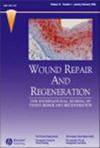miR-146a 的失调与糖尿病足溃疡恶化过程中的炎症、氧化和内质网应激有关
IF 3.8
3区 医学
Q2 CELL BIOLOGY
引用次数: 0
摘要
最近有证据表明,microRNA-146a(miR-146a)在调节炎症反应中起着重要作用。在本研究中,我们探讨了 miRNA-146a 在 2 型糖尿病患者(T2DM)糖尿病足溃疡(DFU)进展中的作用,并研究了其与内质网(ER)和氧化应激等应激介质的相关性。90 名受试者平均分为三组:对照组(30 人)、无并发症的 T2DM 组(30 人)和有足部溃疡的 T2DM 组(30 人)。随后,每组又根据得克萨斯大学的分类法进一步细分。研究人员采集了所有研究对象的外周血,而仅从 DFU 患者身上提取了组织活检样本。使用 miRNA 分离试剂盒从 PBMCs 和伤口组织中分离出总 RNA,并进行 qPCR 检测 miR-146a、ER 应激和氧化应激标记物的表达。我们的研究结果显示,与0级和1级DFU相比,2级和3级DFU的T2DM患者的miR-146a表达量明显下降。值得注意的是,在2级和3级DFU的T2DM患者中,受miR-146a调控的炎症基因,包括TRAF6、IRAK-1和ADAM,都出现了上调。此外,在2级和3级DFU患者中,miR-146a水平的降低与ER应激和氧化应激标志物的增加相关。此外,我们使用小鼠 3T3 成纤维细胞进行的体外实验表明,在诱导高血糖、ER 应激和氧化应激后,这些细胞中的 miR-146a 出现下调。这些研究结果表明,在患有较严重DFU的T2DM患者中,miR-146a表达的减少与氧化应激和ER应激的增加之间存在潜在联系。我们的研究结果表明,以miR-146a为靶点可能有助于缓解与糖尿病并发症相关的氧化应激和ER应激,从而有望控制DFU患者的疾病进展。本文章由计算机程序翻译,如有差异,请以英文原文为准。
Dysregulation of miR‐146a is associated with exacerbated inflammation, oxidative and endoplasmic reticulum stress in the progression of diabetic foot ulcer
Recent evidence has implicated the role of microRNA‐146a (miR‐146a) in regulating inflammatory responses. In the present study, we investigated the role of miRNA‐146a in the progression of diabetic foot ulcer (DFU) in type 2 diabetes mellitus patients (T2DM) and studied its correlation with stress mediators such as Endoplasmic Reticulum (ER) and oxidative stress. Ninety subjects were enrolled and evenly distributed among three groups: Controls (n = 30), T2DM without complications (n = 30) and T2DM with foot ulcers (n = 30). Subsequently, each group was further subdivided based on the University of Texas classification. Peripheral blood was collected from all the study subjects, while tissue biopsies were taken only from DFU patients. Total RNA from both PBMCs and wound tissues were isolated using miRNA isolation kit and qPCR was performed to check the expression of miR‐146a, ER stress and oxidative stress markers. Our findings revealed a significant decrease in miR‐146a expression among T2DM patients with Grade 2 and Grade 3 DFUs compared with those with Grade 0 and Grade 1 DFUs. Notably, inflammatory genes regulated by miR‐146a, including TRAF6, IRAK‐1 and ADAM, were all upregulated in T2DM patients with Grade 2 and Grade 3 DFUs. Moreover, reduced miR‐146a levels were correlated with increased markers of ER stress and oxidative stress in Grade 2 and Grade 3 DFU patients. Furthermore, our in vitro experiment using mouse 3T3 fibroblasts demonstrated a downregulation of miR‐146a following induction of hyperglycaemia, ER stress and oxidative stress in these cells. These findings suggest a potential link between diminished miR‐146a expression and heightened oxidative and ER stress in T2DM patients with more severe grades of DFUs. Our results imply that targeting miR‐146a may hold therapeutic promise for managing disease progression in DFU patients, as it could help alleviate oxidative and ER stress associated with diabetic complications.
求助全文
通过发布文献求助,成功后即可免费获取论文全文。
去求助
来源期刊

Wound Repair and Regeneration
医学-皮肤病学
CiteScore
5.90
自引率
3.40%
发文量
71
审稿时长
6-12 weeks
期刊介绍:
Wound Repair and Regeneration provides extensive international coverage of cellular and molecular biology, connective tissue, and biological mediator studies in the field of tissue repair and regeneration and serves a diverse audience of surgeons, plastic surgeons, dermatologists, biochemists, cell biologists, and others.
Wound Repair and Regeneration is the official journal of The Wound Healing Society, The European Tissue Repair Society, The Japanese Society for Wound Healing, and The Australian Wound Management Association.
 求助内容:
求助内容: 应助结果提醒方式:
应助结果提醒方式:


